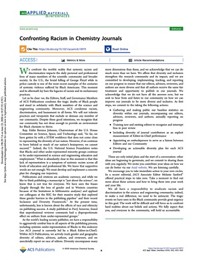Advertisement
Grab your lab coat. Let's get started
Welcome!
Welcome!
Create an account below to get 6 C&EN articles per month, receive newsletters and more - all free.
It seems this is your first time logging in online. Please enter the following information to continue.
As an ACS member you automatically get access to this site. All we need is few more details to create your reading experience.
Not you? Sign in with a different account.
Not you? Sign in with a different account.
ERROR 1
ERROR 1
ERROR 2
ERROR 2
ERROR 2
ERROR 2
ERROR 2
Password and Confirm password must match.
If you have an ACS member number, please enter it here so we can link this account to your membership. (optional)
ERROR 2
ACS values your privacy. By submitting your information, you are gaining access to C&EN and subscribing to our weekly newsletter. We use the information you provide to make your reading experience better, and we will never sell your data to third party members.
Policy
ACS journals enact new safety policy
Authors to be required to address novel or significant hazards
by Jyllian Kemsley
December 1, 2016
| A version of this story appeared in
Volume 94, Issue 48
American Chemical Society journals will have a new safety reporting requirement starting in 2017: Authors must “address and emphasize any unexpected, new, and/or significant hazards or risks associated with the reported work,” says an ACS Central Science editorial describing the change (2016, DOI: 10.1021/acscentsci.6b00341).
ACS Publications editors and staff took a closer look at how the journals addressed safety after a “confluence of events” that included high-profile accidents and a survey of safety policies of chemical journals (J. Chem. Health Saf. 2016, DOI: 10.1016/j.jchas.2015.10.001), says Sarah Tegen, vice president for global editorial and author services at ACS. ACS also publishes C&EN. Previously, individual journals set their own safety policies.
The journals’ Peer Review Advisory Group (PRAG) developed the new wording to make it clear that good safety practice is vital while also being broad enough to be applicable across all the fields that the journals represent, Tegen says.
Reaction from journal editors has been positive. “There is a strong sense that this is the right thing to do,” says Inorganic Chemistry editor-in-chief and PRAG member William B. Tolman.
Beyond including the language in guidelines for authors and reviewers, ACS is leaving individual journal editors to decide how the new requirement is implemented. Tolman, for example, has already added a required check box in a form filled out by Inorganic Chemistry reviewers that asks whether authors have appropriately addressed safety. “It’s a simple and easy way to get the journal community to start paying attention to it,” he says.



Join the conversation
Contact the reporter
Submit a Letter to the Editor for publication
Engage with us on Twitter